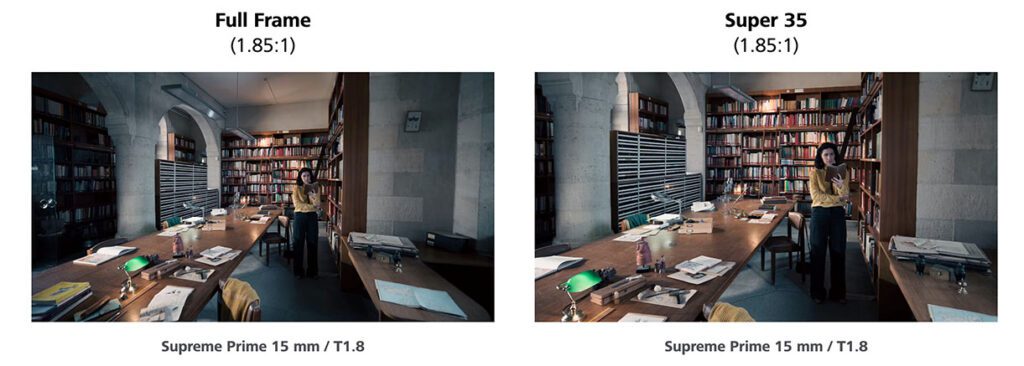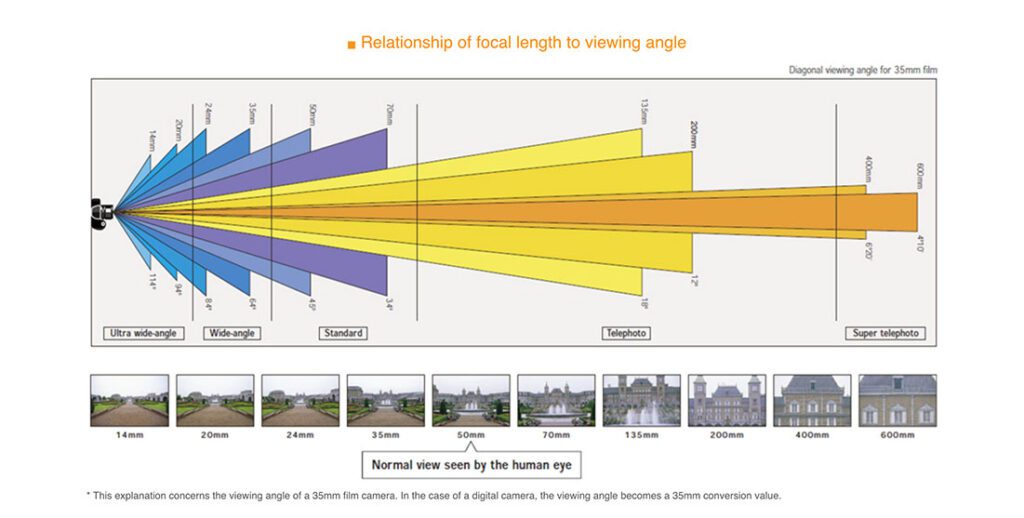Angle of View versus Field of View on Full Frame and Super 35mm
- Greg Kendrick
- February 10, 2024
While planning for an upcoming project a client asked, “Is a 12mm focal length lens a 12mm on both a Full Frame Camera (Alexa Mini LF), and a Super 35 frame camera (Alexa Mini)?”

Standard for Field of View
This brings up the question about what field of view a cinematographer should expect to see from any given focal length lens? The answer depends on whether the cinematographer is accustomed to working in Full Frame or Super 35mm (film or digital). In cinematography, Super 35 was the common standard for decades, meaning the image on a Super 35mm sized film frame was the reference most cinematographers used for imagining what they would see with any given lens. But this reference has been changing with the increasing availability of Full Frame sensors and spherical lenses with Full Frame coverage.
Sensor Sizes
- Super 35mm = 24mm x 18mm (Alexa Mini)
- Full Frame = 36mm x 24mm (Alexa Mini LF)
As the owner of both a Full Frame Alexa Mini LF, and a Super 35mm Alexa Mini, this is interesting to explore because despite having the same degree of view angle the Mini LF would “see more” than the Alexa Mini. I like to think of it like this, the “V” of the view would be the same angle, but the lines of the “V” would be farther apart on a Full Frame camera with a lens that has Full Frame coverage, therefore the Mini LF would have a wider field of view than the Mini. With this in mind, a 12mm focal length lens would be a 12mm, with the same 122 degree angle of view, on both Full Frame and Super 35mm sensors. The specific lens we were discussing for this ultra wide angle was the new Laowa T2.9 Zero-D. Fortunately, with an image circle of 44.7mm, this lens also had Full Frame coverage.
Image Circle

It is also critically important that your lens fully illuminates your entire frame (or portion of the sensor that is being used). If you were to use a lens with Super 35mm coverage on a Full Frame sensor it would porthole, or at a minimum, vignetting heavily. For example, if you used a Cooke S4 on the Alexa Mini LF, you would not get full field illumination. However, there will be no difference in focal length or perspective using a larger format lens on a smaller sensor. In fact, you may have increased performance because you are using less of the outer edges of the lens.

Crop Sensors
Any sensor smaller than Full Frame would be considered a “crop Sensor”. This math can be used to match Fields of View (as opposed to Angles of View), on different sized imagers. While I have never needed to match a specific field of view, it has been very important creatively to have a general idea of what I should expect to see from a camera and lens combination.
Crop Sensor Comparison
- Full Frame: 1x
- Super 35mm: 1.5x
- Micro-Four Thirds: 2x
- Super 16: 3x
Term confusion
In traditional 35mm still photography, the frame measures approximately 36mm x 24mm and is called Full Frame. This frame size was originally called “135 Film” or “135 Format”. A digital camera example would be the Canon 5D Mark IV. This 5D has a sensor size of 36mm x 24mm, so it is called “Full Frame”. Because the frame size was originally called “135 film”, it sounds similar to Super 35, but don’t get the two confused. Remember, a “Super 35” Motion picture film frame measures approximately 24mm x 18mm. Without going on a rabbit trail, Super 35mm film runs through the camera vertically, and Full Frame runs through the camera Horizontally. The Alexa Mini LF is a Full Frame camera and the Alexa Mini and Alexa 35 are Super 35 frame sized cameras.
A personal note
Waywest has invested heavily in super speed glass with Full Frame coverage. For beauty and art, I have chosen the Canon Sumires. While I would love to use vintage glass such as Canon K-35s, Canon FDs, Baltars, Lomos, Kowas, and Zeiss Super Speeds, not all of them cover Full Frame. The Sumires are beautiful, and they have a painterly quality in a modern housing. Wide open the contrast opens-up, and it’s almost as if the out of focus area is softer in the center, than on the edges. This makes the bokeh incredibly interesting! I love this glass and would rather put the money for vintage glass towards crew and lighting.
For commercials, I have chosen the Zeiss Supreme Primes, which are very high end, complimented with the Zeiss Compact Zooms. Both sets are lightweight, compact and cover up to a 43mm image circle. By design the Supremes have a softer, slightly more “vintage” look, as compared to Master Primes, Panavision Primos, or Leica Summilux-C’s. Another noteworthy lens in the arsenal is the Alura 45-250. While the Alura covers Super 35mm, it is one of my favorites when I need a big zoom.
Reference Tools
Focal Length and Field of View
- 8mm-180 deg
- 12mm-122 deg
- 14mm-104 deg
- 18mm-97 deg
- 24mm-73 deg
- 35mm-54 deg
- 50mm-39 deg
- 85mm-23 deg
- 135mm-12 deg
Full Frame
MINI LF
- 8mm
- 12mm
- 14mm
- 18mm
- 24mm
- 35mm
- 50mm
- 85mm
- 135mm
Super 35 Equivalent
Alexa Mini
- 5mm
- 7mm
- 9mm
- 12mm
- 15mm
- 22mm
- 31mm
- 53mm
- 844mm
